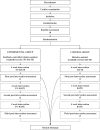Cardiovascular rehabilitation soon after stroke using feedback-controlled robotics-assisted treadmill exercise: study protocol of a randomised controlled pilot trial
- PMID: 24053609
- PMCID: PMC3849994
- DOI: 10.1186/1745-6215-14-304
Cardiovascular rehabilitation soon after stroke using feedback-controlled robotics-assisted treadmill exercise: study protocol of a randomised controlled pilot trial
Abstract
Background: After experiencing a stroke, most individuals also suffer from cardiac disease, are immobile and thus have low endurance for exercise. Aerobic capacity is seriously reduced in these individuals and does not reach reasonable levels after conventional rehabilitation programmes. Cardiovascular exercise is beneficial for improvement of aerobic capacity in mild to moderate stroke. However, less is known about its impact on aerobic capacity, motor recovery, and quality-of-life in severely impaired individuals. The aim of this pilot study is to explore the clinical efficacy and feasibility of cardiovascular exercise with regard to aerobic capacity, motor recovery, and quality-of-life using feedback-controlled robotics-assisted treadmill exercise in non-ambulatory individuals soon after experiencing a stroke.
Methods/design: This will be a single-centred single blind, randomised control trial with a pre-post intervention design. Subjects will be recruited early after their first stroke (≤20 weeks) at a neurological rehabilitation clinic and will be randomly allocated to an inpatient cardiovascular exercise programme that uses feedback-controlled robotics-assisted treadmill exercise (experimental) or to conventional robotics-assisted treadmill exercise (control). Intervention duration depends on the duration of each subject's inpatient rehabilitation period. Aerobic capacity, as the primary outcome measure, will be assessed using feedback-controlled robotics-assisted treadmill-based cardiopulmonary exercise testing. Secondary outcome measures will include gait speed, walking endurance, standing function, and quality-of-life. Outcome assessment will be conducted at baseline, after each 4-week intervention period, and before clinical discharge. Ethical approval has been obtained.
Discussion: Whether cardiovascular exercise in non-ambulatory individuals early after stroke has an impact on aerobic capacity, motor recovery, and quality-of-life is not yet known. Feedback-controlled robotics-assisted treadmill exercise is a relatively recent intervention method and might be used to train and evaluate aerobic capacity in this population. The present pilot trial is expected to provide new insights into the implementation of early cardiovascular exercise for individuals with severe motor impairment. The findings of this study may guide future research to explore the effects of early cardiovascular activation after severe neurological events.
Trial registration: This trial is registered with the Clinical Trials.gov Registry (NCT01679600).
Figures



Similar articles
-
Efficacy of Feedback-Controlled Robotics-Assisted Treadmill Exercise to Improve Cardiovascular Fitness Early After Stroke: A Randomized Controlled Pilot Trial.J Neurol Phys Ther. 2015 Jul;39(3):156-65. doi: 10.1097/NPT.0000000000000095. J Neurol Phys Ther. 2015. PMID: 26050073 Free PMC article. Clinical Trial.
-
Feedback-controlled robotics-assisted treadmill exercise to assess and influence aerobic capacity early after stroke: a proof-of-concept study.Disabil Rehabil Assist Technol. 2014 Jul;9(4):271-8. doi: 10.3109/17483107.2013.785038. Epub 2013 Apr 18. Disabil Rehabil Assist Technol. 2014. PMID: 23597319 Clinical Trial.
-
Visual cue training to improve walking and turning after stroke: a study protocol for a multi-centre, single blind randomised pilot trial.Trials. 2013 Sep 3;14:276. doi: 10.1186/1745-6215-14-276. Trials. 2013. PMID: 24004882 Free PMC article. Clinical Trial.
-
Clinical non-superiority of technology-assisted gait training with body weight support in patients with subacute stroke: A meta-analysis.Ann Phys Rehabil Med. 2020 Nov;63(6):535-542. doi: 10.1016/j.rehab.2019.09.009. Epub 2019 Oct 30. Ann Phys Rehabil Med. 2020. PMID: 31676456
-
Are Aerobic Programs Similar in Design to Cardiac Rehabilitation Beneficial for Survivors of Stroke? A Systematic Review and Meta-Analysis.J Am Heart Assoc. 2019 Aug 20;8(16):e012761. doi: 10.1161/JAHA.119.012761. Epub 2019 Aug 14. J Am Heart Assoc. 2019. PMID: 31409176 Free PMC article.
Cited by
-
Efficacy of Feedback-Controlled Robotics-Assisted Treadmill Exercise to Improve Cardiovascular Fitness Early After Stroke: A Randomized Controlled Pilot Trial.J Neurol Phys Ther. 2015 Jul;39(3):156-65. doi: 10.1097/NPT.0000000000000095. J Neurol Phys Ther. 2015. PMID: 26050073 Free PMC article. Clinical Trial.
References
-
- WHO. World Health Statistics. Geneva, Switzerland: World Health Organization; 2012.
-
- Rosamond W, Flegal K, Friday G, Furie K, Go A, Greenlund K, Haase N, Ho M, Howard V, Kissela B, Kittner S, Lloyd-Jones D, McDermott M, Meigs J, Moy C, Nichol G, O'Donnell CJ, Roger V, Rumsfeld J, Sorlie P, Steinberger J, Thom T, Wasserthiel-Smoller S, Hong Y. American Heart Association Statistics Committee and Stroke Statistics Subcommittee. Heart disease and stroke statistics - 2007 update - A report from the American Heart Association Statistics Committee and Stroke Statistics Subcommittee. Circulation. 2007;115:E69–E171. doi: 10.1161/CIRCULATIONAHA.106.179918. - DOI - PubMed
-
- Di Carlo A. Human and economic burden of stroke. Age Ageing. 2009;38:4–5. - PubMed
Publication types
MeSH terms
Associated data
LinkOut - more resources
Full Text Sources
Other Literature Sources
Medical

